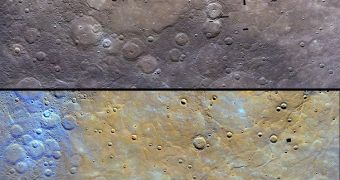Earth definitely has a special appearance, considering the rest of the inner rocky planets in the solar system, but it's definitely not the only world to boast a different type of surface. While Mars and Venus share numerous similarities between themselves, Mercury does not, a new study shows.
The investigation reveals that the innermost planet in the solar system resembles a rare type of meteorite more than it does the other three planets. The similarities are naturally restricted to what its surface looks like.
Astronomers and planetary scientists have reached this conclusion after analyzing images relayed to Earth by the NASA MErcury Surface, Space ENvironment, GEochemistry and Ranging (MESSENGER) spacecraft, which has been orbiting the small world since March 18, 2011.
The orbiter returned sufficient information to enable scientists to gain a deeper understanding of how Mercury formed and evolved over time. The world is located very close to the Sun, completing a full rotation around the star in just 88 days.
Unlike Mars, Jupiter and Saturn, which have been heavily investigated over the years, Mercury has largely been ignored, with a few small exceptions. The MESSENGER mission, which launched on August 3, 2004, now seeks to rectify this oversight, as the first probe to orbit this planet.
What it has learned thus far is that a massive portion of Mercury's surface is covered in now hardened lava. Sufficient amounts of the material exist to cover the entire state of Texas with a thick layer, more than 6.4 kilometers (4 miles) deep, Space reports.
In fact, around 6 percent of the planet's total surface area is covered in lava, which is the equivalent of around 60 percent of the entire continental United States. It's worth mentioning here that the planet itself is only slightly larger than Earth's Moon.
“Being the closest planet to the Sun does mean its formation history would be different and more extreme than the other terrestrial planets, with hotter temperatures and exposure to a stronger gravitational field,” explains Shoshana Weider.
The expert, who holds an appointment as a planetary geologist at the Carnegie Institution of Washington (CIS), was also the lead author of a new study detailing the findings. The work will appear in an upcoming issue of the esteemed Journal of Geophysical Research-Planets.

 14 DAY TRIAL //
14 DAY TRIAL //